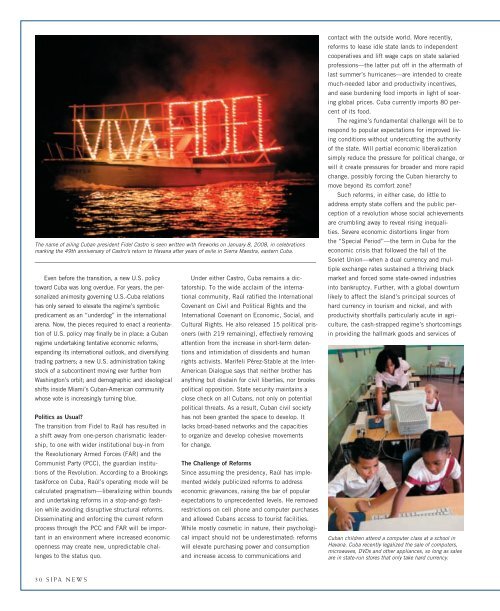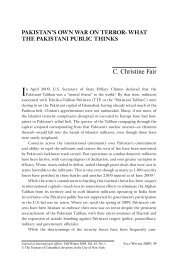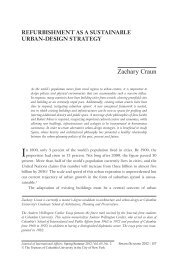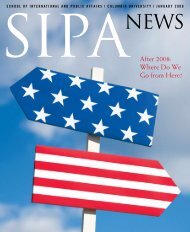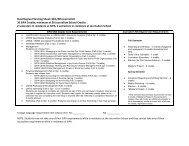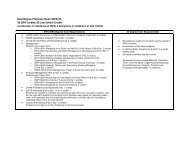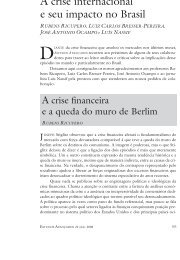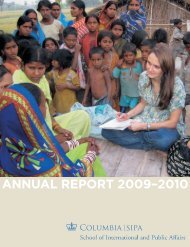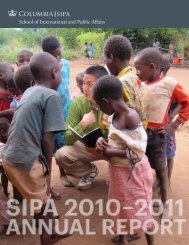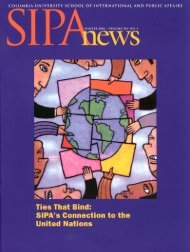SIPANEWS - SIPA - Columbia University
SIPANEWS - SIPA - Columbia University
SIPANEWS - SIPA - Columbia University
You also want an ePaper? Increase the reach of your titles
YUMPU automatically turns print PDFs into web optimized ePapers that Google loves.
The name of ailing Cuban president Fidel Castro is seen written with fi reworks on January 8, 2008, in celebrations<br />
marking the 49th anniversary of Castro’s return to Havana after years of exile in Sierra Maestra, eastern Cuba.<br />
Even before the transition, a new U.S. policy<br />
toward Cuba was long overdue. For years, the personalized<br />
animosity governing U.S.-Cuba relations<br />
has only served to elevate the regime’s symbolic<br />
predicament as an “underdog” in the international<br />
arena. Now, the pieces required to enact a reorientation<br />
of U.S. policy may finally be in place: a Cuban<br />
regime undertaking tentative economic reforms,<br />
expanding its international outlook, and diversifying<br />
trading partners; a new U.S. administration taking<br />
stock of a subcontinent moving ever further from<br />
Washington’s orbit; and demographic and ideological<br />
shifts inside Miami’s Cuban-American community<br />
whose vote is increasingly turning blue.<br />
Politics as Usual?<br />
The transition from Fidel to Raúl has resulted in<br />
a shift away from one-person charismatic leadership,<br />
to one with wider institutional buy-in from<br />
the Revolutionary Armed Forces (FAR) and the<br />
Communist Party (PCC), the guardian institutions<br />
of the Revolution. According to a Brookings<br />
taskforce on Cuba, Raúl’s operating mode will be<br />
calculated pragmatism—liberalizing within bounds<br />
and undertaking reforms in a stop-and-go fashion<br />
while avoiding disruptive structural reforms.<br />
Disseminating and enforcing the current reform<br />
process through the PCC and FAR will be important<br />
in an environment where increased economic<br />
openness may create new, unpredictable challenges<br />
to the status quo.<br />
30 <strong>SIPA</strong> NEWS<br />
Under either Castro, Cuba remains a dictatorship.<br />
To the wide acclaim of the international<br />
community, Raúl ratified the International<br />
Covenant on Civil and Political Rights and the<br />
International Covenant on Economic, Social, and<br />
Cultural Rights. He also released 15 political prisoners<br />
(with 219 remaining), effectively removing<br />
attention from the increase in short-term detentions<br />
and intimidation of dissidents and human<br />
rights activists. Marifeli Pérez-Stable at the Inter-<br />
American Dialogue says that neither brother has<br />
anything but disdain for civil liberties, nor brooks<br />
political opposition. State security maintains a<br />
close check on all Cubans, not only on potential<br />
political threats. As a result, Cuban civil society<br />
has not been granted the space to develop. It<br />
lacks broad-based networks and the capacities<br />
to organize and develop cohesive movements<br />
for change.<br />
The Challenge of Reforms<br />
Since assuming the presidency, Raúl has implemented<br />
widely publicized reforms to address<br />
economic grievances, raising the bar of popular<br />
expectations to unprecedented levels. He removed<br />
restrictions on cell phone and computer purchases<br />
and allowed Cubans access to tourist facilities.<br />
While mostly cosmetic in nature, their psychological<br />
impact should not be underestimated: reforms<br />
will elevate purchasing power and consumption<br />
and increase access to communications and<br />
contact with the outside world. More recently,<br />
reforms to lease idle state lands to independent<br />
cooperatives and lift wage caps on state salaried<br />
professions—the latter put off in the aftermath of<br />
last summer’s hurricanes—are intended to create<br />
much-needed labor and productivity incentives,<br />
and ease burdening food imports in light of soaring<br />
global prices. Cuba currently imports 80 percent<br />
of its food.<br />
The regime’s fundamental challenge will be to<br />
respond to popular expectations for improved living<br />
conditions without undercutting the authority<br />
of the state. Will partial economic liberalization<br />
simply reduce the pressure for political change, or<br />
will it create pressures for broader and more rapid<br />
change, possibly forcing the Cuban hierarchy to<br />
move beyond its comfort zone?<br />
Such reforms, in either case, do little to<br />
address empty state coffers and the public perception<br />
of a revolution whose social achievements<br />
are crumbling away to reveal rising inequalities.<br />
Severe economic distortions linger from<br />
the “Special Period”—the term in Cuba for the<br />
economic crisis that followed the fall of the<br />
Soviet Union—when a dual currency and multiple<br />
exchange rates sustained a thriving black<br />
market and forced some state-owned industries<br />
into bankruptcy. Further, with a global downturn<br />
likely to affect the island’s principal sources of<br />
hard currency in tourism and nickel, and with<br />
productivity shortfalls particularly acute in agriculture,<br />
the cash-strapped regime’s shortcomings<br />
in providing the hallmark goods and services of<br />
Cuban children attend a computer class at a school in<br />
Havana. Cuba recently legalized the sale of computers,<br />
microwaves, DVDs and other appliances, so long as sales<br />
are in state-run stores that only take hard currency.


